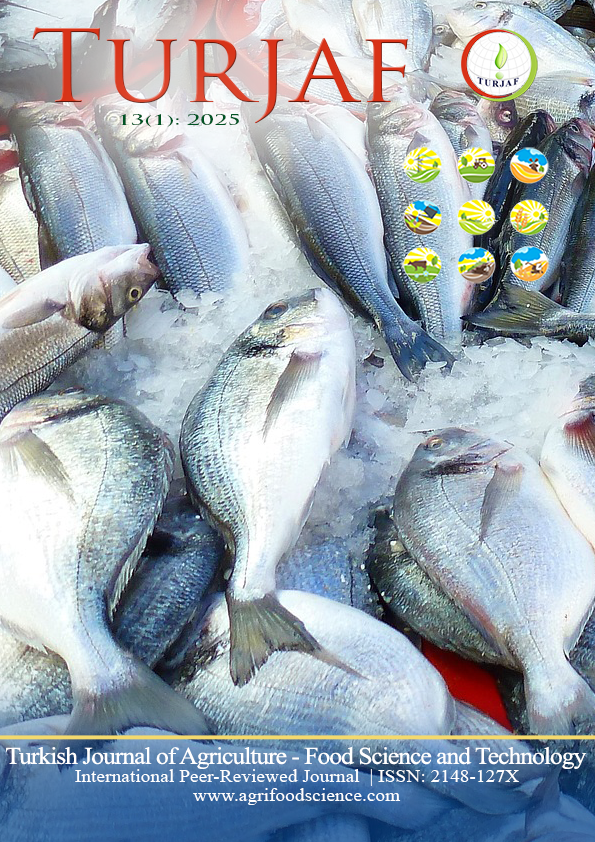Performance of Bell Pepper (Capsicum annum) Under Different Grow Bag Media in Lalitpur District, Nepal
DOI:
https://doi.org/10.24925/turjaf.v13i1.128-133.6922Anahtar Kelimeler:
Grow bag- Growing media- Coco peat- Bell pepper- Vermicompost- FYMÖzet
Promoting rooftop farming using suitable grow bag media is of utmost importance in densely populated cities like Lalitpur to sustain the human race. To assess the productivity and other economic characteristics of bell peppers, an experiment was conducted from Feb 2022 to Jun 2022 in different grow bag media on the premises of Vegetable Crop Development Centre, Khumaltar, Lalitpur. The experiment was conducted in Randomized Complete Block Design (RCBD), with four replications and five treatments with growing media: Coco peat: vermicompost (1:1), Soil: sand: FYM (Farmyard Manure) (1:1:1), Soil: Sand: FYM: Vermicompost (1.25:0.75:0.5:0.5), Soil: vermicompost (1:1), and Soil: ash: FYM (1:0.5:1) on the cultivar California Wonder. Growth parameters like plant height (47.865 cm), number of leaves (50.6), number of branches/plant (9.5), and stem diameter, and yield parameters like total fruit weight (1693.93 gm), average fruit weight (84.68 gm), number of fruits (42.75), fruit diameter (6.37 cm), and fruit length (7.22 cm) were observed during the experiment. The media consisting of T3 (Soil: Sand: FYM: Vermicompost (1.25:0.75:0.5:0.5)) proved to be statistically superior over the rest of the combinations for almost all aspects under investigation, whereas comparatively poor performance was observed in Coco peat: vermicompost (1:1) media. This study suggests that the grow bag media of Soil: Sand: FYM: vermicompost (1.25:0.75:0.5:0.5) gave the highest gross return and net return, with the highest B: C ratio (2.08) observed in the grow bag media of Soil: Sand: FYM (1:1:1).
Referanslar
Abad, M., Noguera, P., Puchades, R., Maquieira, A., & Noguera, V. (2002). Physico-chemical and chemical properties of some coconut coir dust for use as a peat substitute for containerised ornamental plants. Bioresource Technology, 82(3), 241–245. https://doi.org/10.1016/S0960-8524(01)00189-4
Agricultural Issues Center, University of California.
Boriss, H., & Brunke, H. (2005). Commodity Profile: Peppers, Bell, and Chile.
Bosland, P.W. (1996). Capsicums: Innovative Uses of an Ancient Crop. In: J. Janick (ed.), Progress in New Crops. ASHS Press, Arlington, VA. pp. 479-487.
Brunda, S. N., & Singh, D. (2023). Effect of different growing media on capsicum growth, yield and quality under polyhouse conditions. Pharma Innovation, 12(5), 1421–1424.
CBS. (2019). CBS Annual Report. Central Bureau of Statistics.
Chewaka, C., Mohammed, A., & Kassa, N. (2022). Effect of potting media and variety on growth, yield and quality of hot pepper (Capsicum annuum L.) under Jimma condition, South West Ethiopia. Science Research, 10(2), 20–31. https://doi.org/10.11648/j.sr.20221002.11
Denzongpa, R. D., & Sharma, L. (2013). Capsicum cultivation. Retrieved from Krishi Vigyan Kendra Knowledge Network: https://kvk.icar.gov.in/API/Content/PPupload/k0227_82.pdf
Department of Hydrology and Meteorology (DHM). (2022). Climatological Records of Nepal. Ministry of Energy, Water Resources and Irrigation, Government of Nepal. Available at: DHM Climate Services
Gopinath, K.A., Saha, S., Mina, B.L., Kundu, S., Selvakumar, G., Gupta, H.S. (2008). Effect of organic amendments on growth, yield and quality of tomato (Lycopersicon esculentum Mill.) grown under low-temperature conditions. Indian Journal of Agricultural Sciences, 78(9), 803-806.
Govindarajan, V.S. (1986). Capsicum—Production, Technology, Chemistry, and Quality. Part 1: History, Botany, and Breeding. Critical Reviews in Food Science and Nutrition, 24(2), 109-176.
Group, H. (n.d.). Crop guide: Nutrients for pepper. Retrieved from Haifa Group: https://www.haifa-group.com/articles/crop-guide-nutrients-pepperm
Gungor, F., & Yildirim, E. (2013). Effect of different growing media on quality, growth and yield of pepper (Capsicum annuum L.) under greenhouse conditions. Pakistan Journal of Botany, 45(5), 1605–1608.
Hebbar, S. S., Balakrishna, B., Prabhakar, M., Srinivas, V., Nair, A. K., Ravikumar, G., & Rao, M. (2011). Protected cultivation of capsicum. Bengaluru: Indian Institute of Horticultural Research.
Howard, L.R., Talcott, S.T., Brenes, C.H., & Villalon, B. (2000). Changes in phytochemical and antioxidant activity of selected pepper cultivars (Capsicum species) as influenced by maturity. Journal of Agricultural and Food Chemistry, 48(5), 1713-1720.
Kumar, M., & Kohli, U. K. (2005). Capsicum production in naturally ventilated polyhouses in mid hills of Himachal Pradesh. In International Conference on Plasticulture and Precision Farming (pp. 88). New Delhi.
Llaven, M. A. O., Jimenez, J. L. G., Coro, B. I. C., Rosales, R. R., Molina, J. M., Dendooven, L., & Miceli, F. A. G. (2008). Fruit characteristics of bell pepper cultivated in sheep manure vermicompost substituted soil. Journal of Plant Nutrition, 31(9), 1585–1598. https://doi.org/10.1080/01904160802208296
Marin, A., Ferreres, F., Tomas-Barberan, F.A., & Gil, M.I. (2004). Characterization and Quantitation of Antioxidant Constituents of Sweet Pepper (Capsicum annuum L.). Journal of Agricultural and Food Chemistry, 52(12), 3861-3869.
MoALD. (2020). Statistical information on Nepalese agriculture. Ministry of Agriculture and Livestock Development.
NASA POWER. (2022). NASA-National Aeronautics and Space Administration. https://power.larc.nasa.gov/data-access-viewer/
Nath, G., Singh, K., & Singh, D. (2009). Chemical analysis of vermicompost/vermiwash of different combinations of animal, agro and kitchen wastes. Australian Journal of Basic and Applied Sciences, 3(4), 3672–3676.
Navarro, J.M., Flores, P., Garrido, C., & Martinez, V. (2006). Changes in the contents of antioxidant compounds in pepper fruits at ripening stages, as affected by salinity. Food Chemistry, 96(1), 66-73.
Roy, S., Srivastava, A., Kumar, N., & Singh, D. (2010). Effect of organic growing media and crop geometry on growth and yield of capsicum var. California wonders under protected conditions in the northwest Himalayas. Vegetable Science, 38(1), 53–57.
Shinde, P. H. (1992). Evaluation of vermicompost. Pune.
Uma Maheswari, T., & Haripriya, K. (2007). Comparative performance of hot pepper (Capsicum annuum L.) cv. K2 with organic manures and inorganic fertilizers. Research on Crops, 8(3), 761–764.
İndir
Yayınlanmış
Nasıl Atıf Yapılır
Sayı
Bölüm
Lisans
Bu çalışma Creative Commons Attribution-NonCommercial 4.0 International License ile lisanslanmıştır.









